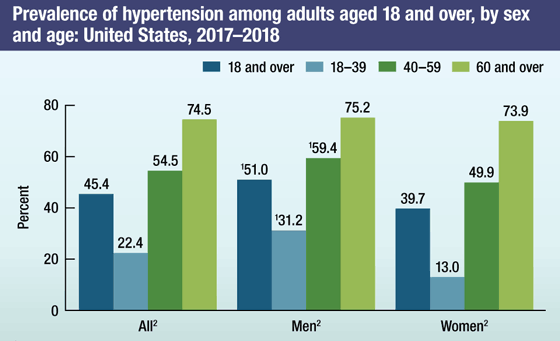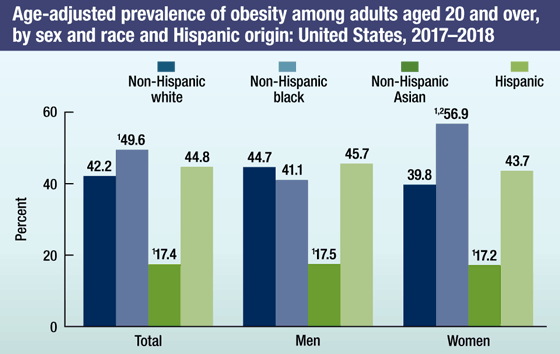National Health and Nutrition Examination Survey
NCHS Fact Sheet, July 2020
About NCHS
The National Center for Health Statistics (NCHS) is the nation’s principal health statistics agency, providing data to identify and address health issues. NCHS compiles statistical information to help guide public health and health policy decisions.
Collaborating with other public and private health partners, NCHS uses a variety of data collection mechanisms to obtain accurate information from multiple sources. This process provides a broad perspective on the population’s health, influences on health, and health outcomes.
National Health and Nutrition Examination Survey
The National Health and Nutrition Examination Survey (NHANES) is NCHS’ most in-depth and logistically complex survey, designed to assess the health and nutritional status of adults and children in the United States. Annually, NHANES examines a nationally representative sample of 5,000 persons of all ages. To produce reliable statistics, the survey oversamples non-Hispanic black and Hispanic persons, and persons aged 60 and over.
NHANES is the only national source of objectively measured health data capable of providing accurate estimates of both diagnosed and undiagnosed conditions. It is unique in that it combines personal interviews with standardized physical examinations, diagnostic procedures, and laboratory tests to determine the prevalence of major diseases and risk factors for diseases. Physical examinations are conducted in mobile examination centers that travel to 15 U.S. counties annually.
Examples of NHANES data
NHANES collects data on a variety of health-related topics, including:
- Obesity
- Diabetes
- Nutrition
- Kidney disease
- Infectious diseases
- Hypertension and cholesterol
- Oral health
- Physical fitness and physical functioning
- Sexual behavior and sexually transmitted diseases
- Environmental exposures
- Supplements and medications
- Cognitive functioning
NHANES data help produce national references for such measurements as height and weight (pediatric growth charts) and blood pressure.
Recent NHANES findings
Prevalence of hypertension among adults
Hypertension (systolic blood pressure greater than or equal to 130 mmHg or diastolic blood pressure greater than or equal to 80 mmHg, or currently taking medication to lower high blood pressure) is a public health challenge in the United States because it directly increases the risk for cardiovascular disease.
- During the survey period 2017–2018, the prevalence of age-adjusted hypertension was 45.4% among adults, and was higher among men (51.0%) than women (39.7%).
- Hypertension prevalence was higher among non-Hispanic black (57.1%) than non-Hispanic white (43.6%) or Hispanic (43.7) adults.
- Overall, hypertension prevalence decreased from 47.0% in 1999–2000 to 41.7% in 2013–2014, and then increased to 45.4% in 2017–2018.

1Significantly different from women within the same age group.
2Significant increasing trend by age.
NOTES: Estimates for age group 18 and over are age adjusted by the direct method to the U.S. Census 2000 population using age groups 18–39, 40–59, and 60 and over. Crude estimates are 48.2% for all persons, 52.5% for men, and 44.0% for women. Access data table for this figure at: https://www.cdc.gov/nchs/data/databriefs/db364-tables-508.pdf#1.
SOURCE: NCHS, National Health and Nutrition Examination Survey, 2017–2018.
Prevalence of obesity among adults
Adult obesity is associated with increased risk of a number of health conditions, including diabetes, hypertension, high cholesterol, cardiovascular disease, stroke, arthritis, and certain cancers. The prevalence of obesity was 42.4% among U.S. adults in 2017–2018.
NHANES data for 2017–2018 show differences by:
Age
- The prevalence of obesity was 40.0% among adults aged 20–39, 44.8% among adults aged 40–59, and 42.8% among adults aged 60 and over. There were no significant differences in prevalence by age group.
Race and ethnicity
- The prevalence of obesity was lowest among non- Hispanic Asian adults (17.4%) compared with non- Hispanic white (42.2%), non-Hispanic black (49.6%), and Hispanic (44.8%) adults. Non-Hispanic black adults had the highest prevalence of obesity compared with all other race and Hispanic-origin groups.
Sex
- The prevalence of obesity was lowest among non- Hispanic Asian women (17.2%) compared with non- Hispanic white (39.8%), Hispanic (43.7%), and non- Hispanic black (56.9%) women, and prevalence among non-Hispanic black women was higher than all other groups.
- Among men, the prevalence of obesity was lowest in non-Hispanic Asian men (17.5%) compared with non- Hispanic white (44.7%), non-Hispanic black (41.1%), and Hispanic (45.7%) men, but there were no significant differences among non-Hispanic white, non-Hispanic black, and Hispanic men.

1Significantly different from all other race and Hispanic-origin groups.
2Significantly different from men for same race and Hispanic-origin group.
NOTES: Estimates were age adjusted by the direct method to the 2000 U.S. Census population using the age groups 20–39, 40–59, and 60 and over. Access data table for this figure at: https://www.cdc.gov/nchs/data/databriefs/db360_tables-508.pdf#2.
SOURCE: NCHS, National Health and Nutrition Examination Survey, 2017–2018.
Additional NHANES findings
Prevalence of severe obesity among adults
- The age-adjusted prevalence of severe obesity among U.S. adults was 9.2% in 2017–2018. Women had a higher prevalence of severe obesity (11.5%) than men (6.9%). The prevalence was highest among adults aged 40–59 (11.5%), followed by adults aged 20–39 (9.1%) and adults aged 60 and over (5.8%). Non-Hispanic black adults had the highest prevalence of severe obesity (13.8%), and non-Hispanic Asian adults had the lowest (2.0%).
NHANES cholesterol data in adults
- During 2015–2018, 11.4% of adults had high measured total cholesterol (serum total cholesterol greater than or equal to 240 mg/dL), and prevalence was similar by race and Hispanic origin.
- Overall, prevalence was higher in adults aged 40–59 (15.7%) than in those aged 20–39 (7.5%) and 60 and over (11.4%). It was also higher in adults aged 60 and over than those aged 20–39.
- Over one-quarter of men (26.6%) and 8.5% of women had low high-density lipoprotein cholesterol (HDL-C) (serum HDL-C less than 40 md/dL).
- The prevalence of low HDL-C was lowest in non- Hispanic black (11.9%) adults compared with non- Hispanic white (16.6%), non-Hispanic Asian (15.8%), and Hispanic (21.9%) adults.
Challenges and future opportunities
- Due to the comprehensive nature of the interviews and examinations, as well as increasing challenges in reaching participants in the household, it is increasingly difficult to maintain survey response rates.
- As health issues and biomedical science advance, a continuing need exists to develop new components in NHANES and related surveys to ensure that needed information can be collected using state-of-the art methods.
For more information about NCHS and its programs, visit https://www.cdc.gov/nchs.
For more information on NHANES, visit https://www.cdc.gov/nchs/nhanes.htm.